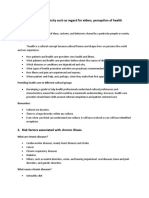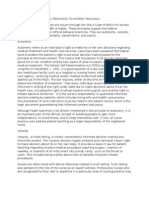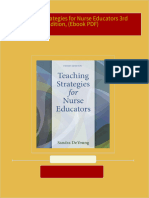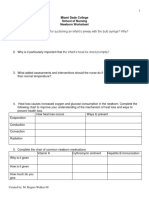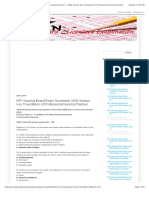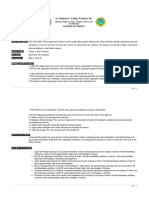NLM Module 7
Uploaded by
ACIO, STEPHANY G.NLM Module 7
Uploaded by
ACIO, STEPHANY G.NUR 412 – Nursing Leadership and Management
Module 7: Intra-disciplinary and Multi- disciplinary
Team Work and Collaboration
Introduction
Multi-disciplinary approaches utilise the skills and experience of individuals
from different disciplines, with each discipline approaching the patient from their own
perspective. Each team member conducted separate assessment, planning and
provision with varying degrees of coordination. The team, directly or indirection, shares
information regarding the patient and discuss future directions for patient care, and
consequently relies on a good communication system (e.g. team meetings, case
conferences etc). Essentially health professionals work in conjunction with each other,
but act autonomously. This is also called multi-professional practice.
Intra-disciplinary team all professionals belong to the same area of expertise
and work towards the achievement of a common goal. It encourages innovation in a
certain field since it brings together professionals in the same field. Intra-disciplinary
team provides a linkage between healthcare workers in the same profession.
Learning Outcome
At the end of this module, the student will be able to:
• Ensure intra-agency, interagency, multi-disciplinary and sectorial collaboration in
the delivery of health care.
• Implement strategies/approaches to enhance/support the capability of the client
and care providers to participate in decision making by the inter-professional
team.
• Maintain harmonious and collegial relationship among members of the health
team for effective, efficient and safe client care.
Nursing Leadership and Management 67
• Coordinate the tasks/functions of the nursing personnel (midwife, BHW and utility
worker.)
• Collaborate with other members of the health team in the implementation of
programs and services.
• Apply principles of partnership and collaboration to improve delivery of health
services.
• Collaborate with GOs, NGOs and other socio-civic agencies to improve health
care services, support environment protection policies and strategies, and safety
and security mechanisms in the community.
• Participate as a member of a quality team in implementing the appropriate quality
improvement process on identified improvement opportunities.
Learning Content
Lesson 1: Concept of Team Collaboration
Collaboration in health care is defined as health care professionals assuming
complementary roles and cooperatively working together, sharing responsibility
for problem-solving and making decisions to formulate and carry out plans for
patient care.
Collaboration between physicians, nurses, and other health care professionals
increases team members’ awareness of each others’ type of knowledge and
skills, leading to continued improvement in decision making.
Effective teams are characterized by trust, respect, and collaboration. Deming is
one of the greatest proponents of teamwork. Teamwork, he believes, is endemic
to a system in which all employees are working for the good of a goal, who have
a common aim, and who work together to achieve that aim.
1. Hospital setting- In hospitals, careful coordination of services between nurses,
nursing assistants, physicians, and a variety of health care professionals
(e.g., physical therapists) must occur around the clock.
Example: A hospitalized patient, for example, may need a physician to
provide a diagnosis and treatment plan, a nurse to administer medications, a
nursing assistant to help with bathing and toiletting, a phlebotomist to take
Nursing Leadership and Management 68
blood samples, a dietitian to monitor food intake, a physical therapist to aid in
muscle strengthening and flexibility, and a social worker to coordinate home
care following release.
2. Community setting – Working as a team in the delivery of health services is a
cornerstone of primary health care and one of the greatest benefits of working
in a remote and rural context. Health teams are composed of members from
different healthcare professions with specialised skills and expertise, who
communicate and collaborate to plan and provide quality health services.
The foundation of the community health record is establishing a high-
functioning collaborative of engaged community health stakeholders. Real
collaboration occurs when stakeholders agree to align efforts and share
information to address a common goal. These collaborations require trust and
time to develop and begin with focusing on a win–win outcome. They rely on a
core group of project champions from each organization who are willing to listen,
share responsibilities, do things differently, pool resources, work together, and
take collective action. Sustaining the collaborative is vital for information sharing.
Lesson 2: Development of Team And Collaboration
Six Ways to Improve Collaboration on Nursing Teams
1. Look in the mirror.
Effective collaboration with the other members of your team starts with
you, which makes self-awareness your first step. After all, if you don’t understand
what makes you tick, you can’t expect your colleagues to figure it out. Take
another look at the list above and ask yourself honestly which of those points
make you tense. Do you bristle when dealing with people who went to a better
(or worse) school than you did? Are you self-conscious about the way you speak
or your experience and credentials?
If you’re new to this kind of self-analysis, ask a trusted friend to help you.
Being aware of your own triggers and hot buttons will help you develop
techniques for dealing with them before you reach the point of throwing down
your stethoscope and stalking out the door.
2. Create a safe space to share information.
No one likes being yelled at, dismissed or ridiculed for offering an opinion
or asking a question. If those reactions are part of your organizational culture,
they will shame people into silence, which is an enormous barrier to good
Nursing Leadership and Management 69
teamwork. Mutually beneficial relationships depend on the sharing of information,
which makes it vital that team members listen to one another and reinforce the
value of each other’s input.
Practice listening and responding constructively to the other people on
your team even when you disagree or when they ask a question whose answer
seems obvious to you. Doing that will help create an environment where team
members - including you - don’t have to suffer in silence for not having all the
answers.
3. Handle conflict with care.
There’s no healthcare environment on Earth that’s free of conflict, which is
why it’s important to manage it well. In fact, some experts point to poor conflict
management as the single most critical obstacle to effective collaboration.
4. Belong to the right team.
The best care is provided by truly interdisciplinary teams in which
professionals from different areas meld their diverse knowledge and experience
to achieve a common goal. Sadly, too many supposedly interdisciplinary teams
are really multidisciplinary. They are collections of professionals so focused on
their own precious areas of practice that the idea of listening to or involving
anyone else in a meaningful way just isn’t in the cards.
5. Communicate effectively.
There are several facets to this one. Communications between nurses is
comparatively easy because nurses usually understand each other pretty well.
The important points there include clarity, honesty, compassion, and respectfully
resolving grievances rather than letting them ferment into grudges.
6. Be a leader.
Real leaders don’t need a leadership title. If you’re a nurse, you’re a
leader — period. You’re the hub of all things related to patient care, providing
expertise, guidance and support in a hundred different ways each time you snap
on your badge. There are more people counting on you than you may realize and
your patients are just a few. Be a role model for those around you by asking for
help when you need it, circling the wagons to solve an issue and being generous
with your praise.
Nursing Leadership and Management 70
Lesson 3: Tools for Facilitating Health Care Team Work
Tools are instruments that could be implemented relatively independently in
order to structure, facilitate or trigger teamwork.
1. Structuring tools
Teamwork can be structured by using the structured communication
technique SBAR (Situation, Background, Assessment, and Recommendation),
(de)briefing checklists, and rounds.
SBAR is often studied in combination with strategies to facilitate
implementation, such as didactic sessions, training, information material, and
modifying SBAR material (e.g. cards) . In addition, this subcategory entails
communication techniques similar or based on SBAR. One study focused on
nursing homes, while the remaining studies were performed in a hospital setting.
Most studies found improvements in communication; however, a few found
mixed results. Only (very) low-level evidence studies were identified.
Briefings and debriefings create an opportunity for professionals to
systematically communicate and discuss (potential) issues before or after
delivering care to a patient, based on a structured format of elements/topics or a
checklist with open and/or closed-end questions.
Rounds can be described as structured interdisciplinary meetings around a
patient. Rounds were solely researched in hospital settings. Five studies found
improvements in non-technical skills, one study in technical skills, and one study
reported outcomes but found no improvement.
2. Facilitating tools
Teamwork can be facilitated through technology. Technology, such as
telecommunication, facilitates teamwork as it creates the opportunity to involve
and interact with professionals from a distance. Technology also creates
opportunities to exchange information through information platforms. Most
studies found positive results for teamwork. Studies were performed in a hospital
setting and presented a level of evidence varying from moderate to very low.
3. Triggering tools
Teamwork could be triggered by tools that monitor and visualize
information, such as (score) cards and dashboards. The gathered information
does not echo team performance but creates incentives for reflecting on and
Nursing Leadership and Management 71
improving teamwork. Team processes (e.g. trust, reflection) are also triggered
by sharing experiences, such as clinical cases and stories, thoughts of the day.
All seven studies showed improvements in non-technical skills and had a very
low level of evidence.
Lesson 4: Nurses Role in Establishing Collaborative Relationship in the Delivery
of Health Care Programs and Services
Nurses are the only clinical professionals who are specially trained to understand
the roles of other healthcare providers.
Effective communication is critical for a collaborative care plan to work; nurses
are trained to have adaptability, empathy, and communication skills, which allows
for them to be excellent leaders and members of a care team.
Nurses’ ability to understand and assess a patient’s clinical, emotional, and
social needs can help them to call upon available resources and create a patient-
focused care plan. As nurses are offering direct patient care around the clock, they
have a unique and focused view of how that care should be provided.
Nurses can be role models in their honest and open communication with team
members about the quality of patient care which is being provided and the work
environment.
Recommended learning materials and resources for supplementary reading
Intra- and Interdisciplinary Teamwork and Collaboration. Available at:
https://www.youtube.com/watch?v=LsHM_IAGUt8
Multidisciplinary Teams. Available at:
https://www.youtube.com/watch?v=XwF1TXsq9hY
References:
Nursing Leadership and Management 72
Health Times. 2020. Nurses in collaborative care teams. Retrieved at:
https://healthtimes.com.au/hub/nursing-careers/6/guidance/ht1/nurses-in-
collaborative-care-teams/2879/
King RJ, Garrett N, Kriseman J, Crum M, Rafalski EM, Sweat D, et al. 2016. A
community health record: improving health through multisector collaboration,
information sharing, and technology. Prev Chronic Dis 2016;13:160101. DOI:
http://dx.doi.org/10.5888/pcd13.160101. Retrieved at
https://www.cdc.gov/pcd/issues/2016/16_0101.htm
Montgomery, S. Six ways to improve collaboration on nursing teams. The goal is to
overcome obstacles. 2008. Retrieved at
https://www.workingnurse.com/articles/Six-Ways-to-Improve-Collaboration-on-
Nursing-Teams
Robson W. 2017. Tools and techniques to improve teamwork and avoid patient harm.
Nursing Times; 113: 1, 24-27.
Rosen, M. A., et al. 2019. Teamwork in healthcare: Key discoveries enabling safer,
high-quality care. Am Psychol. 2018 May-Jun; 73(4): 433–450. doi:
10.1037/amp0000298. Retrieved at:
https://www.ncbi.nlm.nih.gov/pmc/articles/PMC6361117/
Nursing Leadership and Management 73
You might also like
- Cultural Factor/ethnicity Such As Regard For Elders, Perception of Health100% (1)Cultural Factor/ethnicity Such As Regard For Elders, Perception of Health3 pages
- Concepts and Principles of Partnership Collaboration and TeamworkNo ratings yetConcepts and Principles of Partnership Collaboration and Teamwork6 pages
- The Primary Barriers To An Accessible Quality Healthcare in The Philippines Are The Shortage of Hospitals and Surgical EquipmentNo ratings yetThe Primary Barriers To An Accessible Quality Healthcare in The Philippines Are The Shortage of Hospitals and Surgical Equipment3 pages
- Group 1 Physiological Changes in Aging Affecting Various SystemsNo ratings yetGroup 1 Physiological Changes in Aging Affecting Various Systems22 pages
- Instant Download Teaching Strategies for Nurse Educators 3rd Edition, (Ebook PDF) PDF All Chapters100% (3)Instant Download Teaching Strategies for Nurse Educators 3rd Edition, (Ebook PDF) PDF All Chapters41 pages
- Comparison of Nursing Process and Teaching ProcessNo ratings yetComparison of Nursing Process and Teaching Process1 page
- Political Activism in Nursing Final PresentationNo ratings yetPolitical Activism in Nursing Final Presentation30 pages
- Pulido, Nathaniel T. (Quiz - Activity 6)No ratings yetPulido, Nathaniel T. (Quiz - Activity 6)2 pages
- I. Overview of Informatics and Nursing Informatics InformaticsNo ratings yetI. Overview of Informatics and Nursing Informatics Informatics25 pages
- Lesson 1: Concepts of Community Health Nursing100% (1)Lesson 1: Concepts of Community Health Nursing2 pages
- Week 15 16 Leadership and Management Roles of PMHN in An Organization and ResearchBAUTISTANo ratings yetWeek 15 16 Leadership and Management Roles of PMHN in An Organization and ResearchBAUTISTA49 pages
- Nursing Board:Licensure Exam Answer Key: NP1 Nursing Board Exam November 2008 Answer Key 'Foundation of Professional Nursing Practice'No ratings yetNursing Board:Licensure Exam Answer Key: NP1 Nursing Board Exam November 2008 Answer Key 'Foundation of Professional Nursing Practice'6 pages
- NCM 118 Critical Thinking Exercises No. 1No ratings yetNCM 118 Critical Thinking Exercises No. 12 pages
- Brushing and Flossing The Teeth of Conscious and Unconscious Client Procedure ChecklistNo ratings yetBrushing and Flossing The Teeth of Conscious and Unconscious Client Procedure Checklist6 pages
- Terminologies: 1. THEORETICAL FOUNDATION OF NURSING - The Central Concept of Health, Person, EnvironmentNo ratings yetTerminologies: 1. THEORETICAL FOUNDATION OF NURSING - The Central Concept of Health, Person, Environment12 pages
- Introduction To Health Assessment ConceptsNo ratings yetIntroduction To Health Assessment Concepts29 pages
- CHAPTER 4 and 5.the Calling of Health Care Provider100% (1)CHAPTER 4 and 5.the Calling of Health Care Provider17 pages
- CA REVIEWER (TFN) Divinagracia, Betty&AbaquinNo ratings yetCA REVIEWER (TFN) Divinagracia, Betty&Abaquin9 pages
- 1 - Introduction To Fundamentals of Nursing100% (1)1 - Introduction To Fundamentals of Nursing19 pages
- Ventricular Septal Defect, A Simple Guide To The Condition, Treatment And Related ConditionsFrom EverandVentricular Septal Defect, A Simple Guide To The Condition, Treatment And Related ConditionsNo ratings yet
- GEC 7 (Chapter 4 Topic 1 - Basic Areas of Ethical Study)No ratings yetGEC 7 (Chapter 4 Topic 1 - Basic Areas of Ethical Study)8 pages
- GEC 7 (Chapter 1 Topic 1 Basic Concepts in Ethics)No ratings yetGEC 7 (Chapter 1 Topic 1 Basic Concepts in Ethics)6 pages
- Cultural Factor/ethnicity Such As Regard For Elders, Perception of HealthCultural Factor/ethnicity Such As Regard For Elders, Perception of Health
- Concepts and Principles of Partnership Collaboration and TeamworkConcepts and Principles of Partnership Collaboration and Teamwork
- The Primary Barriers To An Accessible Quality Healthcare in The Philippines Are The Shortage of Hospitals and Surgical EquipmentThe Primary Barriers To An Accessible Quality Healthcare in The Philippines Are The Shortage of Hospitals and Surgical Equipment
- Group 1 Physiological Changes in Aging Affecting Various SystemsGroup 1 Physiological Changes in Aging Affecting Various Systems
- Instant Download Teaching Strategies for Nurse Educators 3rd Edition, (Ebook PDF) PDF All ChaptersInstant Download Teaching Strategies for Nurse Educators 3rd Edition, (Ebook PDF) PDF All Chapters
- Comparison of Nursing Process and Teaching ProcessComparison of Nursing Process and Teaching Process
- I. Overview of Informatics and Nursing Informatics InformaticsI. Overview of Informatics and Nursing Informatics Informatics
- Week 15 16 Leadership and Management Roles of PMHN in An Organization and ResearchBAUTISTAWeek 15 16 Leadership and Management Roles of PMHN in An Organization and ResearchBAUTISTA
- Nursing Board:Licensure Exam Answer Key: NP1 Nursing Board Exam November 2008 Answer Key 'Foundation of Professional Nursing Practice'Nursing Board:Licensure Exam Answer Key: NP1 Nursing Board Exam November 2008 Answer Key 'Foundation of Professional Nursing Practice'
- Brushing and Flossing The Teeth of Conscious and Unconscious Client Procedure ChecklistBrushing and Flossing The Teeth of Conscious and Unconscious Client Procedure Checklist
- Terminologies: 1. THEORETICAL FOUNDATION OF NURSING - The Central Concept of Health, Person, EnvironmentTerminologies: 1. THEORETICAL FOUNDATION OF NURSING - The Central Concept of Health, Person, Environment
- CHAPTER 4 and 5.the Calling of Health Care ProviderCHAPTER 4 and 5.the Calling of Health Care Provider
- Ventricular Septal Defect, A Simple Guide To The Condition, Treatment And Related ConditionsFrom EverandVentricular Septal Defect, A Simple Guide To The Condition, Treatment And Related Conditions
- Exam Prep for:: Guide to Nursing Management and LeadershipFrom EverandExam Prep for:: Guide to Nursing Management and Leadership
- GEC 7 (Chapter 4 Topic 1 - Basic Areas of Ethical Study)GEC 7 (Chapter 4 Topic 1 - Basic Areas of Ethical Study)
- GEC 7 (Chapter 1 Topic 1 Basic Concepts in Ethics)GEC 7 (Chapter 1 Topic 1 Basic Concepts in Ethics)


